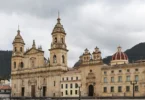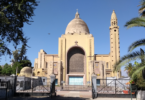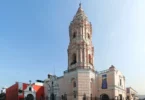Introduction
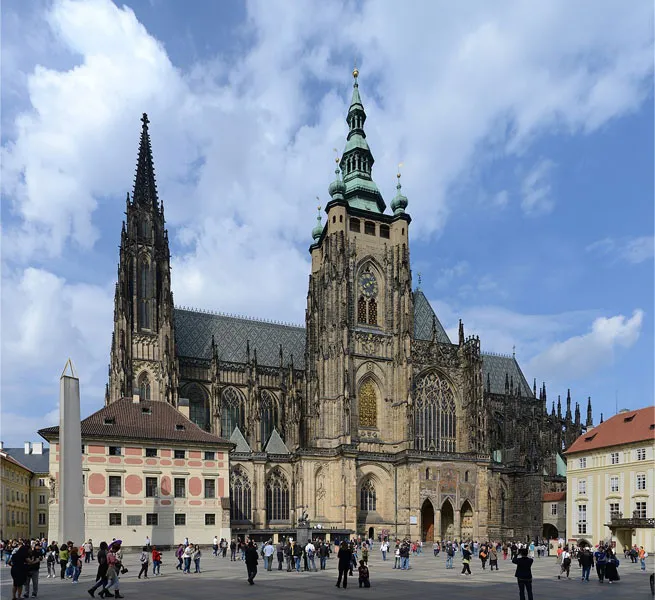
The Metropolitan Cathedral of Saints Vitus, Wenceslaus and Adalbert (Czech: metropolitní katedrála svatého Víta, Václava a Vojtěcha) is a Catholic metropolitan cathedral in Prague, and the seat of the Archbishop of Prague. Until 1997, the cathedral was dedicated only to Saint Vitus, and is still commonly named only as St. Vitus Cathedral (Czech: katedrála svatého Víta or svatovítská katedrála).
This cathedral is a prominent example of Gothic architecture, and is the largest and most important church in the country. Located within Prague Castle and containing the tombs of many Bohemian kings and Holy Roman Emperors, the cathedral is under the ownership of the Czech government as part of the Prague Castle complex. Cathedral dimensions are 124 m × 60 m (407 ft × 197 ft), the main tower is 102.8 m (337 ft) high, front towers 82 m (269 ft), arch height 33.2 m (109 ft).
The magnificent St. Vitus Cathedral is a vital part of the history of Prague Castle. It was founded in 1344 and took nearly 600 years to be constructed. The grand interiors of this Gothic masterpiece boast a range of wonders, including the beautifully decorated St. Wenceslas Chapel with the tomb of Saint Wenceslas, the crypt where many Czech kings are buried, and the Crown Chamber, home to the Bohemian crown jewels. St. Vitus Cathedral is the largest and the most important temple in Prague. Apart from religious services, coronations of Czech kings and queens also took place here. The cathedral is a place of burial of several patron saints, sovereigns, noblemen and archbishops. The St. Vitus Cathedral in Prague castle is one of the most important buildings in the Czech republic and former Bohemian kingdom. The Gargoyles of St. Vitus Cathedral were actually created by multiple sculptors. Due to this, you won’t find two similar ones on the facade. Even before it was completely built, St. Vitus Cathedral, Prague, regularly held masses, funerals, and coronations.
St. Vitus Cathedral is a Gothic masterpiece located in Prague, Czech Republic. Its construction began in 1344 under the patronage of Charles IV, the Holy Roman Emperor and King of Bohemia. Matthias of Arras designed it, and later by Peter Parler, who also designed the Charles Bridge and other notable buildings in Prague. The cathedral is named after Saint Vitus, a Christian martyr from the 4th century. During the Hussite Wars in the 15th century, the cathedral was damaged and remained unfinished for centuries.
It was in the 19th century that the cathedral was finally completed. St. Vitus Cathedral symbolized Czech national pride and was the site of many important events in Czech history, including the coronations of Czech kings and queens. The cathedral is the burial place of several patron saints and Czech kings, including Saint Wenceslaus, the Duke of Bohemia, and Charles IV. Today, St. Vitus Cathedral remains a vital part of the religious and cultural life of the Czech state. Its architecture and rich history make it a popular tourist destination and an important symbol of Czech identity.
The construction of the present-day Gothic Cathedral started on 21 November 1344. King John of Bohemia laid the foundation stone for the new building, and construction later continued under the reign of Charles IV. Mathew of Arras and Peter Parler were the two architects who worked on the construction of St. Vitus Cathedral in Prague Castle. However, the construction work came to halt when a new king, Charles’s son Wenceslas IV, came to power. Moreover, when the Hussite War broke out in 1419, St. Vitus Church stood unfinished for almost 600 years! The war and a destructive fire heavily damaged parts of the cathedral and its furnishings.
Built over a time span of almost 600 years, St Vitus is one of the most richly endowed cathedrals in central Europe. It is pivotal to the religious and cultural life of Czechia, housing treasures that range from the 14th-century mosaic of the Last Judgement and the tombs of St Wenceslas and Charles IV, to the baroque silver tomb of St John of Nepomuk, the ornate Chapel of St Wenceslas and art-nouveau stained glass by Alfons Mucha. At first glance the cathedral’s western facade, which looms above the entrance to the Third Courtyard, looks impressively Gothic, but in fact the triple doorway dates only from 1953, making it one of the last parts of the church to be completed. The foundation stone was laid in 1344 by Emperor Charles IV, on the site of a 10th-century Romanesque rotunda built by Duke Wenceslas. Charles’ original architect, Matthias of Arras (Matyáš z Arrasu), began work in 1344 on the choir in the French Gothic style, but died eight years later. His German successor, Peter Parler – a veteran of Cologne’s cathedral – completed most of the eastern part of the cathedral in a freer, late-Gothic style before he died in 1399. Renaissance and baroque details were added over the following centuries, but it was only in 1861, during the Czech National Revival, that a concerted effort was made to finish the cathedral – everything between the western door and the crossing was built during the late 19th and early 20th centuries. It was finally consecrated in 1929.
The cathedral is the third church consecrated to the same saint on the same site. Around the year 925, Prince Wenceslas (Václav) founded a Romanesque rotunda here, which after 1060 was converted into a basilica with three naves and two steeples. The importance of the church grew especially after the establishment of the Prague bishopric in 973 and the founding of the body of canons – the St. Vitus chapter, which later became an important cultural and administrative institution. In 1344, Charles IV began the construction of a Gothic cathedral. Its first builders, Matthias of Arras and later Peter Parler, built the chancel with a ring of chapels, St. Wenceslas Chapel, the Golden Gate and the lower part of the Great South Tower. It was already Peter Parler who started the construction of the South Tower, however he did not complete it. In the 16th century, is was finished with a Renaissance view gallery and a helmet. Later in the 18th century, the older helmet was replaced by a new dome.
Unfortunately, in 1419 the construction of the Cathedral stopped because of the Hussite Wars. In spite of the endeavours of some sovereigns to secure the continuation of the construction work, the Cathedral remained uncompleted for whole centuries. The facade of the Cathedral was provisionally closed and for example the music choir was bulit. It was not until the latter half of the 19th century that the Union for the Completion of the Cathedral began the repair of the original part and the completion of the Cathedral in Neo-Gothic style. The church was solemnly consecrated in 1929. Its interior was subjected to adaptations even in later years. Visitors enter the Cathedral through the portal in the western facade, opposite the passage-way between the Second and Third Courtyard of Prague Castle. Its bronze door is decorated with reliefs with scenes from the history of the Cathedral and from the legends about St. Wenceslas and St. Adalbert.
The Neo-Gothic part of the Cathedral consists of the main nave and the narrow side aisles, lined with chapels, and the northern wing of the transverse nave. The chapels have stained glass windows. In the cross nave, the ceremonial entrance into the Cathedral can be seen – the Golden Gate – leading to the Third Courtyard. Situated in the chancel of the Cathedral, in front of the high altar, is the Royal Mausoleum below which there is the royal crypt. The chancel is surrounded by a ring of Gothic chapels. Czech sovereigns and patron saints are interred in some of them.
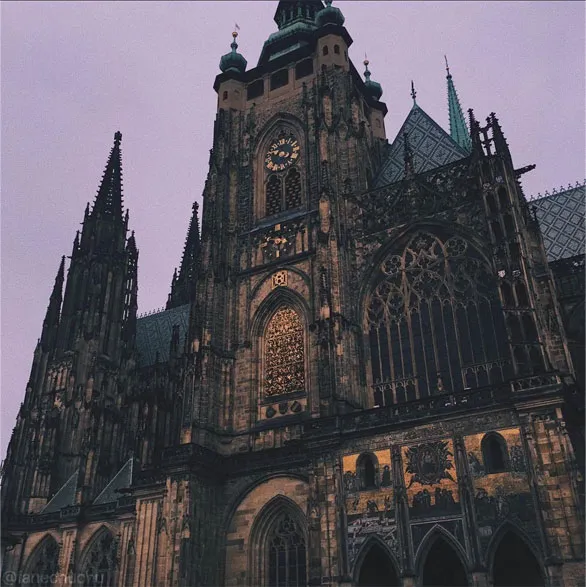
Recent History
In 1997, on 1000th anniversary of the death of Saint Adalbert, the patrocinium (dedication) of the church was re-dedicated to Saint Wenceslaus and Saint Adalbert. The previous Romanesque basilica had this triple patrocinium to the main Bohemian patrons since 1038 when relics of Saint Adalbert were placed here. The skull of Saint Adalbert is kept at the Hilbert Treasury.
In 1954, a government decree entrusted the whole Prague Castle into ownership of “all Czechoslovak people” and into administration of the President’s Office. Beginning in 1992, after the Velvet Revolution the church filed several petitions requesting a determination on the true owner of the structure. After 14 years, in June 2006, the City Court in Prague decided that the 1954 decree did not change the ownership of the cathedral and the owner is the Metropolitan Chapter at Saint Vitus. In September 2006, the President’s Office ceded the administration to the Metropolitan Chapter. However, in February 2007, the Supreme Court of the Czech Republic reversed the decision of the City Court and returned the case to the common court. In September 2007, the District Court of Prague 7 decided that the cathedral is owned by the Czech Republic, this decision was confirmed by the City Court in Prague and the Constitutional Court rejected the appeal of the Metropolitan Chapter, however noted that the chapter unquestionably owns the interior furnishings of the cathedral. The Metropolitan Chapter considered continuing the case in the European Court for Human Rights however in May 2010, the new Prague Archbishop Dominik Duka and the state president Václav Klaus together declared that they did not wish to continue with court conflicts. They constituted that the seven persons who are traditionally holders of the keys of the Saint Wenceslaus Chamber with the Bohemian Crown Jewels become also a board to coordinate and organize administration and use of the cathedral. However, controversy about ownership of some related canonry houses continues.
In July 2012, the Chamber of Deputies passed a bill to compensate the churches for property seized by the Communist government. The Senate approved the bill in November 2012 and the government implemented it the following June after clearing legal challenges.
Architecture of St. Vitus Cathedral Prague
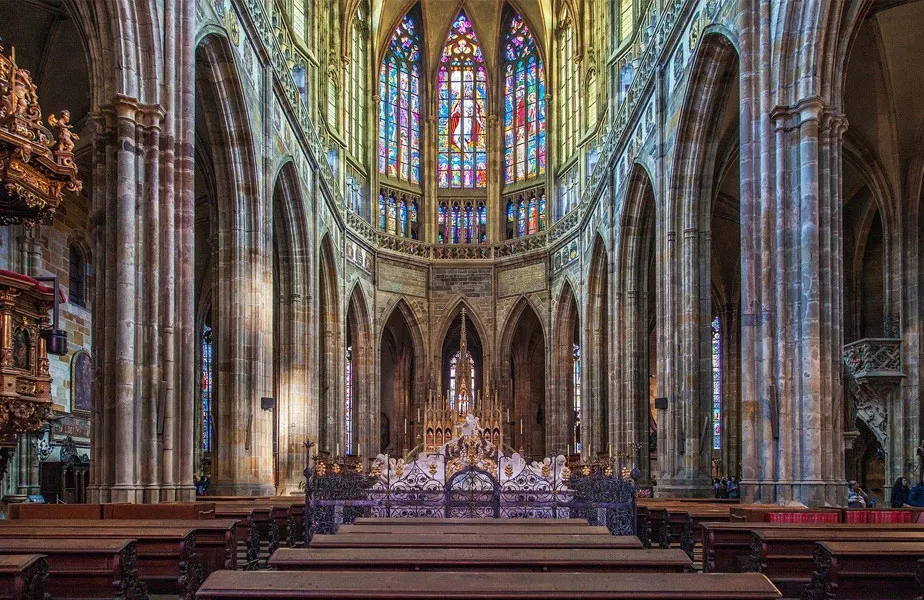
Architectural styles: Gothic architecture
Architects: Peter Parler, Matthias of Arras, Josef Mocker, Kamil Hilbert, Josef Kranner, Wenzel Parler, Johann Parler
St. Vitus Cathedral is a perfect example of Gothic architecture. The exterior of the cathedral is characterized by its tall spires, intricate carvings, and flying buttresses. The cathedral’s main facade is dominated by the monumental west window, which is the largest in Europe. The window features intricate tracery and stunning stained glass, depicting scenes from the Bible and the life of St. Vitus. The interior of the cathedral is equally impressive, with its tall nave and vaulted ceilings, adorned with intricate ribbing and decorations. The nave features a stunning rose window, which is one of the most impressive pieces of stained glass in the world. The cathedral’s choir is home to the stunning St. Wenceslas Chapel, which features a beautiful mosaic depicting the life of the patron saint of the Czech Republic.
Prague Castle is one of the biggest tourist attractions in the city. This complex is the largest of its kind in the world, and people visit to marvel at the site. Inside the castle complex lies St. Vitus Cathedral, the biggest cathedral in the Czech Republic and a wonder of Gothic architecture. The St. Vitus Cathedral is named after the saint, St. Vitus, and was commissioned by Holy Roman Emperor Charles IV. Its construction began in the mid-13th century and came to a grinding halt in the early 1400s due to ongoing wars. It was finally completed in 1929 but would continue to be remodeled even after this date. In both the exterior and interior of the building, one can see all Gothic architecture’s trademarks. The whole of the cathedral embodies the grand, lofty look that characterizes the style and spires aid in giving it additional height. Flying buttresses, which act as support beams and allow for a more stable structure, are also utilized. Ornate stone detailing, called tracery, can be found throughout the exterior.
The inside of St. Vitus Cathedral also exhibits the Gothic style’s hallmarks, and it is, in a word, stunning. Natural light is allowed to flood in through stained glass windows, some of which were designed by Art Nouveau artists. The stained glass in the northern part of the cathedral, created by Alphonse Mucha, is particularly remarkable in its vivid colors. It depicts portraits of saints and episodes from their lives. The same intricate tracery utilized on the exterior of the building can also be found lining the interior. These large windows are possible due to the pointed arches that line the inside of the building, as they provide additional support and negate the need for a solid wall. This type of arch had been utilized by different cultures due to their strength and was used by Gothic architects as a way to build tall, airy structures. Additional stability is given by the ribbed vaulting on the ceiling.
But the St. Vitus Cathedral holds more cultural significance than just its beautiful appearance. It also contains a chapel that features the tomb of St. Wenceslas. Beyond the chapel is the Crown Chamber, where the Bohemian Crown Jewels, like the Wenceslas Crown and the Royal Sceptre, are kept under heavy surveillance. The Royal Mausoleum lies under the cathedral and contains the tombs of past emperors and empresses. Regular services are still held inside the cathedral, and free tours are available as well as paid ones. Should you ever visit historic Prague Castle, stepping inside the St. Vitus Cathedral to view the impressive architecture, beautiful stained glass windows, and a piece of Czech culture is a necessity.
Cathedral’s Exterior
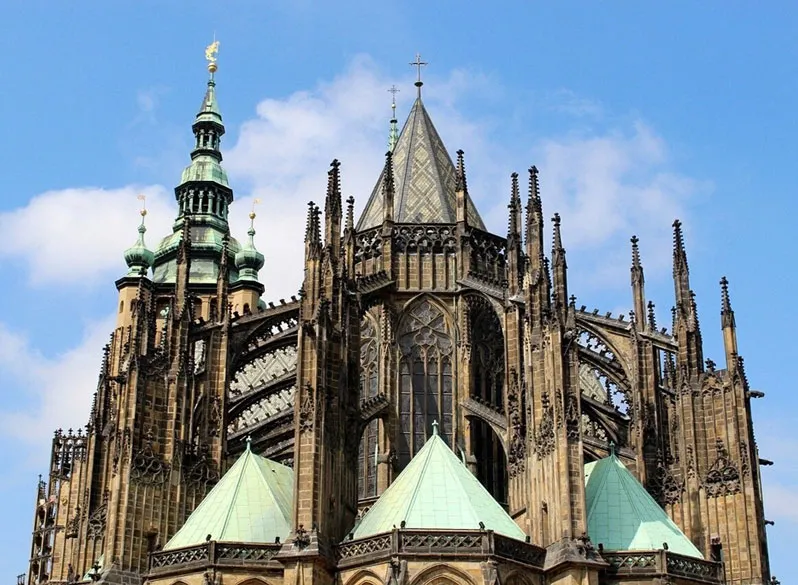
The front with two slender towers is decorated with 14 statues of saints, Charles IV and archbishop Arnošt of Pardubice on pillars. Three portals with tympanons decorated with reliefs according to models of Karel Dvořák lead to the main aisle, with bronze doors with cast reliefs by Otakar Španiel. The rosette window above the portal with a diameter of 10 m has been created according to cartons of František Kysela on the theme of World’s Creation from 1921. The ceremonious entrance to the temple is located in the Southern front at the 3rd courtyard, the so called Golden Door. It is decorated with unique Gothic Italian-type mosaic on the theme of the Last Judgement with a depiction of Charles IV and his wife Elisabeth of Pomerania, created during the years 1370 – 1371 by anonymous mosaic makers from approximately one million of glass pieces and marbles in more than 30 colour shades. Within the entrance, there is a modern bronze grille, decorated with reliefs of a calendar and Zodiac signs, made by Jaroslav Horejc in 1955. On this side, the Southern observation tower rises up (287 steps) with a Renaissance gallery 56 m high and a Baroque Pacassi’s cupola to which a 3.5 m high, gold-plated lion is attached. The unfinished tower from 1419 was completed by Bonifác Wohlmut and Hans Tirol in 1560 – 1562 after the Hussite Wars. The tower is also called the great bell tower.
Cathedral’s Interiors
St. Vitus Cathedral is imposing in its size. The length is 124 meters, the maximum width – 60 meters and the height of the vaults is 33 meters. Twenty-eight columns support the vaults. A wreath of 19 chapels surrounds the side aisles. Stained-glass windows are from 1925 -1939. They were created by Max Svabinsky, Frantisek Kisela, Alfons Mucha, Karl Svolinsky, and others. Many Czech dukes and kings (including Charles IV and Rudolph II), bishops, archbishops, and other high-ranking officials are buried here. According to the 14th-century traditions, only the highest representatives of state and church could be buried in the cathedral. Despite this, we can find gravestones of the builders – Matthias of Arras and Petr Parler – in the Waldstein Chapel. Also, four saints – St. Sygizmund, St.Adalbert, St. John of Nepomuk, and St. Wenceslas – are buried in the cathedral.

Origins
The current cathedral is the third of a series of religious buildings at the site, all dedicated to St. Vitus. The first church was an early Romanesque rotunda founded by Wenceslaus I, Duke of Bohemia in 930. This patron saint was chosen because Wenceslaus had acquired a holy relic – the arm of St. Vitus – from Emperor Henry I. It is also possible that Wenceslaus, wanting to convert his subjects to Christianity more easily, chose a saint whose name (Svatý Vít in Czech) sounds very much like the name of Slavic solar deity Svantevit.[citation needed] Two religious populations, the increasing Christian and decreasing pagan community, lived simultaneously in Prague castle at least until the 11th century.
In the year 1060, as the bishopric of Prague was founded, prince Spytihněv II embarked on building a more spacious church, as it became clear the existing rotunda was too small to accommodate the faithful. A much larger and more representative Romanesque basilica was built in its spot. Though still not completely reconstructed, most experts agree it was a triple-aisled basilica with two choirs and a pair of towers connected to the western transept. The design of the cathedral nods to Romanesque architecture of the Holy Roman Empire, most notably to the abbey church in Hildesheim and the Speyer Cathedral. The southern apse of the rotunda was incorporated into the eastern transept of the new church because it housed the tomb of St. Wenceslaus, who had by now become the patron saint of the Czech princes. A bishop’s mansion was also built south of the new church, and was considerably enlarged and extended in the mid-12th century.
The Gothic cathedral
Construction of the present-day Gothic cathedral began on 21 November 1344, when the seat of Prague was elevated to an archbishopric. King John of Bohemia laid the foundation stone for the new building. The patrons were the chapter of cathedral (led by a dean), the Archbishop Arnost of Pardubice, and, above all, Charles IV, King of Bohemia and a soon-to-be Holy Roman Emperor, who intended the new cathedral to be a coronation church, family crypt, treasury for the most precious relics of the kingdom, and the last resting place cum pilgrimage site of patron saint Wenceslaus. The first master builder was a Frenchman Matthias of Arras, summoned from the Papal Palace in Avignon. Matthias designed the overall layout of the building as, basically, an import of French Gothic: a triple-naved basilica with flying buttresses, short transept, five-bayed choir and decagon apse with ambulatory and radiating chapels. However, he lived to build only the easternmost parts of the choir: the arcades and the ambulatory. The slender verticality of Late French Gothic and clear, almost rigid respect of proportions distinguish his work today.
After Matthias’ death in 1352, 23-year-old Peter Parler assumed control of the cathedral workshop as master builder. He was son of the architect of the Heilig-Kreuz-Münster in Schwäbisch Gmünd. Initially, Parler only worked on plans left by his predecessor, building the sacristy on the north side of the choir and the chapel on the south. Once he finished all that Matthias left unfinished, he continued according to his own ideas. Parler’s bold and innovative design brought in a unique new synthesis of Gothic elements in architecture. This is best exemplified in the vaults he designed for the choir. The so-called Parler’s vaults or net-vaults have double (not single, as in classic High Gothic groin vaults) diagonal ribs that span the width of the choir-bay. The crossing pairs of ribs create a net-like construction (hence the name), which considerably strengthens the vault. They also give a lively ornamentation to the ceiling, as the interlocking vaulted bays create a dynamic zigzag pattern the length of the cathedral. While Matthias of Arras was schooled as a geometer, thus putting an emphasis on rigid systems of proportions and clear, mathematical compositions in his design, Parler was trained as a sculptor and woodcarver. He treated architecture as a sculpture, almost as if playing with structural forms in stone. Aside from his bold vaults, the peculiarities of his work can also be seen in the design of pillars (with classic, bell-shaped columns which were almost forgotten by High Gothic), the ingenious dome vault of new St. Wenceslaus chapel, the undulating clerestory walls, the original window tracery (no two of his windows are the same, the ornamentation is always different) and the blind tracery panels of the buttresses. Architectural sculpture was given a considerable role while Parler was in charge of construction, as can be seen in the corbels, the passageway lintels, and, particularly, in the busts on the triforium, which depict faces of the royal family, saints, Prague bishops, and the two master builders, including Parler himself.
Work on the cathedral, however, proceeded slowly, because the Emperor commissioned Parler with many other projects, such as the construction of the new Charles Bridge in Prague and many churches throughout the Czech realm. By 1397, when Peter Parler died, only the choir and parts of the transept were finished. After Peter Parler’s death in 1399 his sons, Wenzel Parler and particularly Johannes Parler, continued his work; they in turn were succeeded by a certain Master Petrilk, who by all accounts was also a member of Parler’s workshop. Under these three masters, the transept and the great tower on its south side were finished. So was the gable which connects the tower with the south transept. Nicknamed ‘Golden Gate’ (likely because of the golden mosaic of Last Judgment depicted on it), it is through this portal that the kings entered the cathedral for coronation ceremonies.
The entire building process came to a halt with the beginning of Hussite War in the first half of 15th century. The war brought an end to the workshop that operated steadily over for almost a century, and the furnishings of cathedral, dozens of pictures and sculptures, suffered heavily from the ravages of Hussite iconoclasm. As if this was not enough, a great fire in 1541 heavily damaged the cathedral.
St. Wenceslaus Chapel
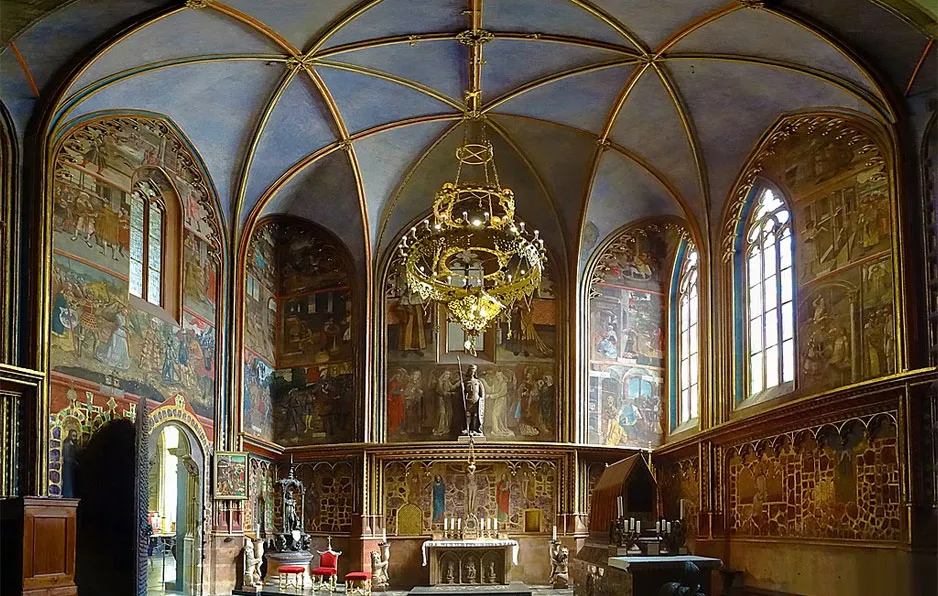
Perhaps the most outstanding place in the cathedral is the Chapel of St. Wenceslaus, which houses relics of the saint. Peter Parler constructed the room between 1356 (the year he took over) and 1364 with a ribbed vault. The lower portions of the walls are decorated with over 1300 semi-precious stones and paintings depicting the Passion of Christ dating from the original decoration of the chapel in 1372–1373. The upper area of the walls have paintings depicting the life of St. Wenceslaus, by the Master of the Litoměřice Altarpiece between 1506 and 1509. Above the altar, is a Gothic statue of St. Wenceslaus created by Jindřich Parler (Peter’s nephew) in 1373. The chapel is not open to the public, but it can be viewed from the doorways.
A small door with seven locks, in the southwest corner of the chapel, leads to the Crown Chamber containing the Czech crown jewels, which are displayed to the public only once every (circa) eight years.
Renaissance and Baroque
Through most of the following centuries, the cathedral stood only half-finished. It was built to the great tower and a transept, which was closed by a provisional wall. In the place of a three-aisled nave-to-be-built, a timber-roofed construction stood, and services were held separately there from the interior of the choir. Several attempts to continue the work on the cathedral were mostly unsuccessful. In the latter half of the 15th century, king Vladislaus II commissioned the great Renaissance-Gothic architect Benedict Ried to continue the work on the cathedral, but almost as soon as the work began, it was cut short because of lack of funds. Later attempts to finish the cathedral only brought some Renaissance and Baroque elements into the Gothic building, most notably the obviously different Baroque spire of the south tower by Nikolaus Pacassi (1753 until 1775) and the great organ in the northern wing of transept.
Completion in 19th and 20th century
In 1844, Václav Pešina, an energetic St. Vitus canon, together with Neo-Gothic architect Josef Kranner presented a program for renovation and completion of the great cathedral at the gathering of German architects in Prague. The same year a society under the full name “Union for Completion of the Cathedral of St. Vitus in Prague” was formed, whose aim was to repair, complete and rid the structure of everything mutilated and stylistically inimical. Josef Kranner headed the work from 1861 to 1866 which consisted mostly of repairs, removing Baroque decorations deemed unnecessary and restoring the interior. In 1870 workers finally laid the foundations of the new nave, and in 1873, after Kranner’s death, architect Josef Mocker assumed control of the reconstruction. He designed the west façade in a typical classic Gothic manner with two towers, and the same design was adopted, after his death, by the third and final architect of restoration, Kamil Hilbert.
In the 1920s the sculptor Vojtěch Sucharda worked on the façade, and the famous Czech Art Nouveau painter Alfons Mucha decorated the new windows in the north part of nave. Frantisek Kysela designed the rose window from 1925 to 1927, which depicts scenes from the Biblical story of creation. By the time of St. Wenceslaus jubilee in 1929, the St. Vitus cathedral was finally finished, nearly 600 years after it was begun. Despite the fact that the entire western half of the cathedral is a Neo-Gothic addition, much of the design and elements developed by Peter Parler were used in the restoration, giving the cathedral as a whole a harmonious, unified look.
Organ
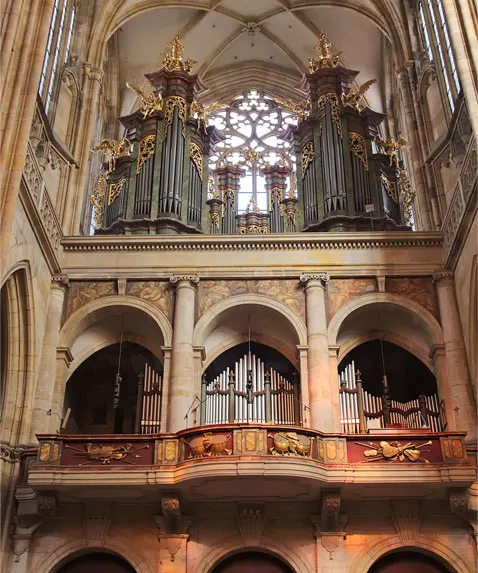
The St. Vitus Cathedral has two organ casings. The upper façade belonged to a baroque organ, which was built in 1765 by Anton Gartner. It had 40 stops on 3 manuals and pedals. This case is purely decorative. The associated work was transported around 1909 and was lost. The lower neoclassical casing contains today’s main organ. It was built by Josef Melzel in the years 1929–31. A general overhaul was carried out by the organ builder Brachtl a Kánský (1999–2001). The rather modest instrument in relation to the large church space has 58 stops on 3 manuals and pedals, 4,475 pipes in total. The action is purely pneumatic. With a large number of basic pipes (flutes and principals) and little reeds (trumpets), the instrument has a rather gentle tone – a typical feature of post-Romantic organs.
The Stained glass windows
Immerse yourself in the mesmerizing beauty of St. Vitus Cathedral’s stained glass windows. These kaleidoscopic works of art depict biblical scenes and saints, flooding the interior with a glorious array of hues. Witness the interplay of light and color that creates a truly enchanting ambiance.
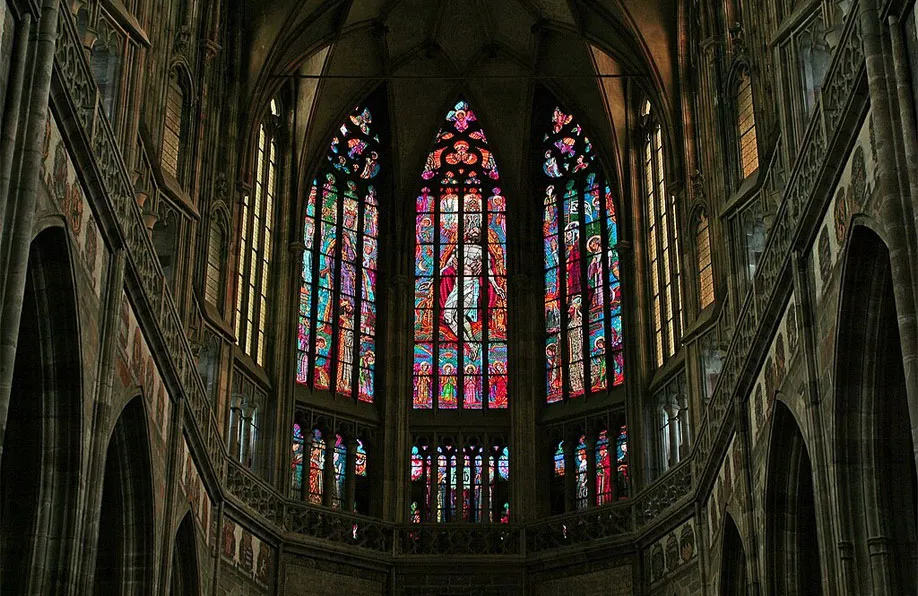
The Royal Mausoleum
The Royal Mausoleum is where Czech kings and queens found their eternal repose. Pay homage to the illustrious rulers who shaped the nation’s history as you wander through this solemn space. The tombs, adorned with exquisite stone carvings, serve as a poignant reminder of the monarchy’s legacy.
The Great South Tower
Ascend the St. Vitus Cathedral tower to catch breathtaking panoramic views of Prague. Climb the winding staircase, and your efforts will be rewarded with a sweeping vista of the city’s rooftops, spires, and the majestic Vltava River. This bird’s-eye view will leave you in awe of Prague’s architectural splendor.
The Golden Portal
Prepare to be awe-struck as you pass through the magnificent Golden Portal. This ornate entrance, adorned with intricate sculptures and gilded details, welcomes visitors with regal splendor. Step into a world where craftsmanship meets grandeur and makes you feel like royalty.
The Main Nave
Enter the majestic main nave of the cathedral, where soaring ceilings and towering columns create a sense of heavenly grandeur. Let your gaze wander upwards, and be captivated by the intricate ribbed vaults that seem to touch the heavens themselves.
The Crown Jewels
Marvel at the glittering Crown Jewels, displayed in all their regal glory. These symbols of Czech sovereignty include the Crown of Saint Wenceslas, the Royal Scepter, and the Coronation Mantle. Let the magnificence of these priceless treasures transport you to a time of kings and queens.
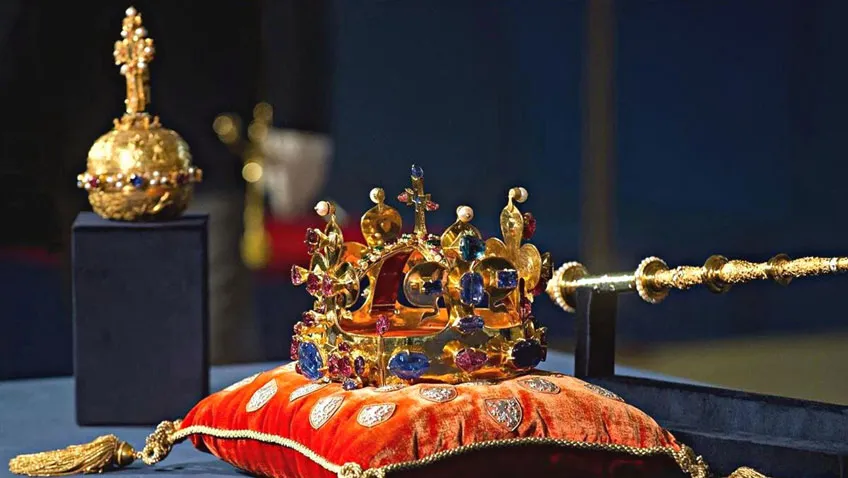
The Giant Bell
Listen for the resounding toll of the Giant Bell, the sonorous heartbeat of St. Vitus Cathedral. This colossal bell, named Sigismund, weighs a staggering 15 tons and is an emblem of Czech national pride. Let its deep resonance reverberate within you, filling you with a sense of awe and reverence.
Tomb of St John of Nepomuk
In a silver tomb adorned with Baroque statues lies Saint Nepomuk, priest and martyr, whose statue stands on Charles Bridge. He is the patron saint of the Czech Republic. Drowned in the Vltava River at the behest of King Wenceslas, he became the first Czech martyr.

Significance of St. Vitus Cathedral
St. Vitus Cathedral is not only a symbol of architectural brilliance but also an important cultural and religious landmark. The cathedral has been the site of numerous important events throughout its history, including the coronation of Czech kings and queens. It also houses the tombs of several Bohemian kings, including Charles IV and Wenceslas IV. St. Vitus Cathedral is also an important pilgrimage site for Catholics and a must-visit destination for tourists.
Completion of the Cathedral
It took a long 585 years before the St. Vitus Cathedral was actually completed. The temple, in the construction of which more than a dozen of the greatest architects of its time participated, was consecrated and officially opened on September 28, 1929 in the presence of President Tomáš Garrigue Masaryk and Archbishop František Kordač.
St. Vitus Cathedral Today
St. Vitus Cathedral has witnessed countless significant events, including royal coronations, weddings, and even religious services through the centuries. It has survived wars, political changes, and the test of time, standing tall as a testament to the city’s enduring spirit and faith. The St. Vitus Cathedral architecture is considered a stunning work of art today, attracting millions of visitors annually. Its soaring spires and majestic facade dominate the Prague skyline, beckoning all who come to explore its hallowed halls. Beyond its sheer beauty, the St. Vitus Cathedral holds immense cultural and religious importance. It remains the seat of the Archbishop of Prague, symbolizing the spiritual heart of the Czech Republic.
Annual Feast Day
Feast day: 15 June
The annual feast day of The Church of St. Vitus Cathedral Prague, Czechia is celebrated on June 15 each year.
Mass Timing
Summer Season (April 1 – October 31) timings:
Monday – Saturday: 9 AM – 5 PM
Sunday: 12 PM – 5 PM
Winter Season (November 1 – March 31) timings:
Monday – Saturday: 9 AM – 4 PM
Sunday: 12 PM – 4 PM
Closed on: December 24
Contact Info
III. nádvoří 48/2,
Prague Castle 119 01 Prague 1 – Hradčany,
Czechia.
Phone No.
Phone: +420 224 372 434
Accommodations
Connectivities
Airway
The nearest airport to The Church of St. Vitus Cathedral Prague Czechia is, Václav Havel Airport Prague, which is just 20 min (12.0 km) via Evropská away from the basilica.
Railway
The nearest railway to The Church of St. Vitus Cathedral Prague Czechia , Prague Main Railway Station, Vinohrady which is just 10 min (5.6 km) via nábř. E. Beneše away from the basilica.


